
Yucca is a genus of perennial shrubs and trees in the family Asparagaceae, subfamily Agavoideae. Its 40–50 species are notable for their rosettes of evergreen, tough, sword-shaped leaves and large terminal panicles of white or whitish flowers. They are native to the Americas and the Caribbean in a wide range of habitats, from humid rainforest and wet subtropical ecosystems to the hot and dry (arid) deserts and savanna.

Yucca brevifolia is a plant species belonging to the genus Yucca. It is tree-like in habit, which is reflected in its common names.
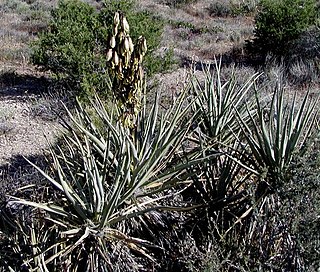
Yucca baccata is a common species of yucca native to the deserts of the southwestern United States and northwestern Mexico, from southeastern California north to Utah, east to western Texas and south to Sonora and Chihuahua. It is also reported in the wild in Colombia.
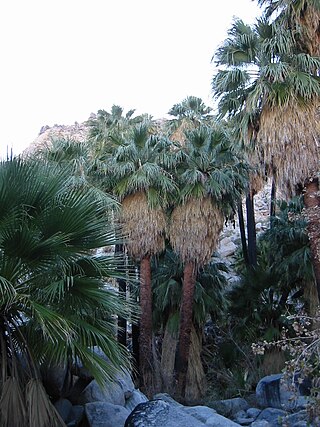
Washingtonia filifera, the desert fan palm, California fan palm, or California palm, is a flowering plant in the palm family Arecaceae, native to the far southwestern United States and Baja California, Mexico. Growing to 15–20 m (49–66 ft) tall by 3–6 m (10–20 ft) broad, it is an evergreen monocot with a tree-like growth habit. It has a sturdy, columnar trunk and waxy, fan-shaped (palmate) leaves.

The Arizona Cactus Garden, or, officially, Arizona Garden, also known as the Cactus Garden, is a small botanical garden specializing in cactus and succulents. It is located on the campus of Stanford University, in Stanford, California, US. It is open to the public daily without charge.

Yucca gigantea is a species of flowering plant in the asparagus family, native to Mexico and Central America. Growing up to 8–12 m (26–39 ft) in height, it is an evergreen shrub which is widely cultivated as an ornamental garden or house plant, often referred to simply as yucca cane. The edible flower is the national flower of El Salvador locally called izote, and it is used extensively in Salvadoran cuisine.

Yucca glauca is a species of perennial evergreen plant, adapted to xeric (dry) growth conditions. It is also known as small soapweed, soapweed yucca, Spanish bayonet, and Great Plains yucca.
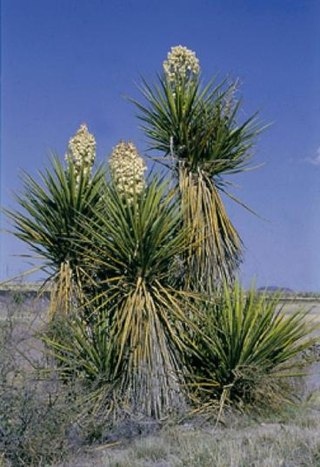
Yucca faxoniana is a bladed evergreen shrub of the genus Yucca. It is known by the common names Faxon yucca,Spanish dagger, and giant dagger.

Yucca × schottii is a plant species in the genus Yucca, native to southern Arizona, southwestern New Mexico, and the northern parts of Sonora and Chihuahua. The common names are Schott's yucca, hoary yucca, and mountain yucca. The "×" in the name indicates that this is a nothospecies, regarded as being a natural hybrid between two other species. In this case, Yucca × schottii is believed to have originated as a hybrid between Y. baccata and Y. madrensis. Yucca × schottii is firmly established and does reproduce freely in the wild.
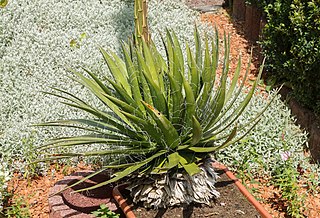
Agave filifera, the thread agave, is a species of flowering plant in the family Asparagaceae, native to Central Mexico from Querétaro to Mexico State. It is a small or medium-sized succulent plant that forms stemless rosette up to 3 feet (91 cm) across and up to 2 feet (61 cm) tall. The leaves are dark green to a bronzish-green in color and have very ornamental white bud imprints. The flower stalk is up to 11.5 feet (3.5 m) tall and is densely loaded with yellowish-green to dark purple flowers up to 2 inches (5.1 cm) long. Flowers appear in autumn and winter.

Yucca jaliscensis is a Yucca species native to the highlands of southwestern Mexico. Common names for this species include Jalisco Yucca, Jalisco Soapwort, Izote Yucca. It is native to mountainous areas at about 5000 feet in the States of Jalisco, Colima and Guanajuato.

Yucca angustissima, the narrowleaf yucca, is a plant in the family Agavaceae, known as the "narrow-leaved yucca." It is native to Arizona, New Mexico, Colorado and Utah, but grown elsewhere as an ornamental.

Yucca decipiensTrel. is a large, branching member of the Asparagaceae, native to north-central Mexico from Durango to San Luís Potosí. It is evergreen, up to 20 feet tall, growing at elevations of 1500–2000 m in the mountains. Common name is "palma china," which means "Chinese palm."
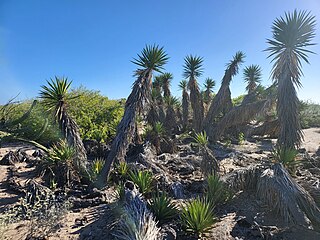
Yucca valida is a plant species in the family Asparagaceae, native to the Mexican states of Baja California, Baja California Sur, Sonora, and Sinaloa. The common name is datilillo.

Yucca baileyi is a plant in the family Agavaceae. It is native to Utah, Arizona, New Mexico and Colorado but has been cultivated elsewhere. Much of its native range is within the boundaries of the Navajo (Diné) Reservation, hence the common name "Navajo yucca." The Navajo people make extensive use of yucca fibers to make a wide assortment of useful and ceremonial items. They also use the roots as soap. It is not considered to be threatened, as it has a large range and an overall stable population.
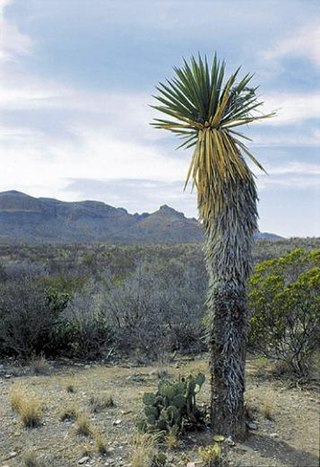
Yucca carnerosana, commonly known as the giant Spanish dagger, is a species of North American plant in the asparagus family that grows in arid and desert climate areas. In the United States, it is confined to only a few counties in western Texas, where endemic populations are found in rocky outcrops. The species is, however, widely distributed in northern Mexico. It has a wide range and is abundant, and although it has local threats, its population appears to be stable overall.

Yucca harrimaniaeTrel., the Spanish bayonet, is a species in the family Asparagaceae, native to Utah, Nevada, Colorado, northeastern Arizona and northern New Mexico, at elevations from 1000 m to 2700 m.

Yucca thompsoniana, the Thompson's yucca, is a plant in the family Asparagaceae, native to Texas, Chihuahua and Coahuila. Other names for the plant include Beaked yucca, Soyate and Palmita.
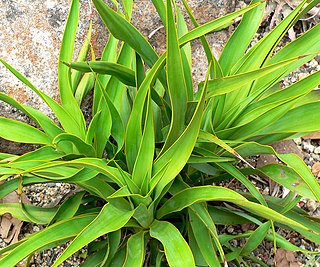
Yucca rupicola is a plant in the family Asparagaceae, known as the twistleaf yucca, twisted-leaf yucca, Texas yucca or twisted-leaf Spanish-dagger. The species was described by George Heinrich Adolf Scheele in 1850. This is a small, acaulescent plant with distinctive twisted leaves. It is native to the Edwards Plateau region of Texas and also to northeastern Mexico.

Yucca aloifolia is the type species for the genus Yucca. Common names include aloe yucca, dagger plant, and Spanish bayonet. It grows in sandy soils, especially on sand dunes along the coast.






















